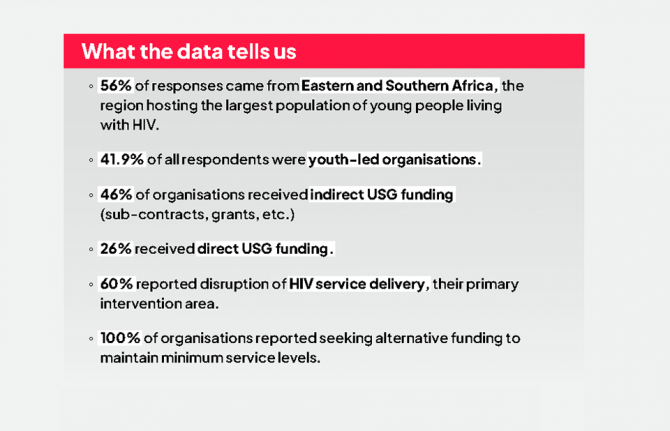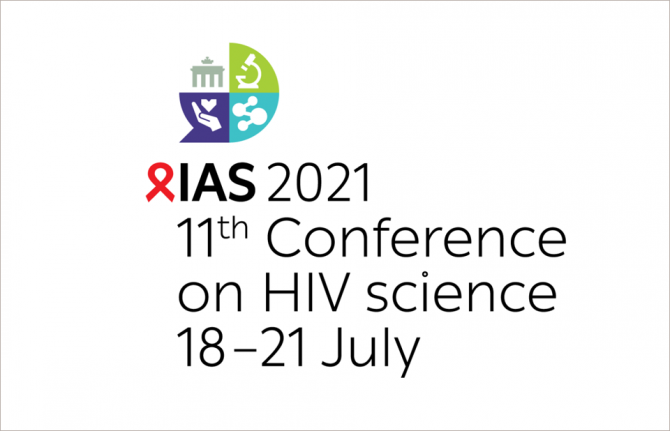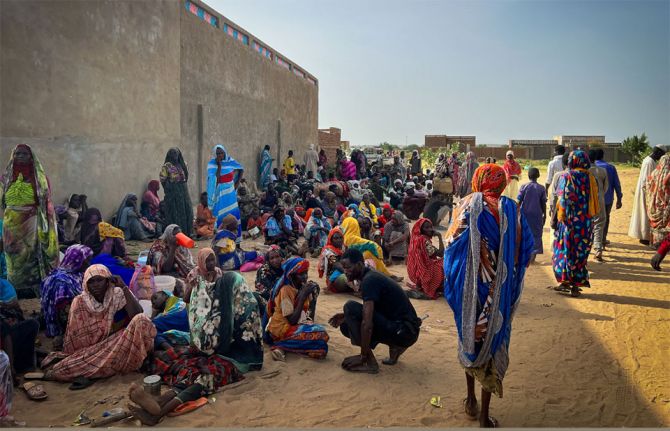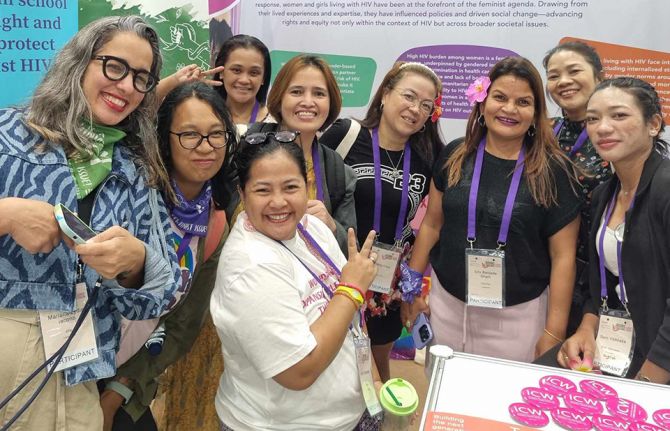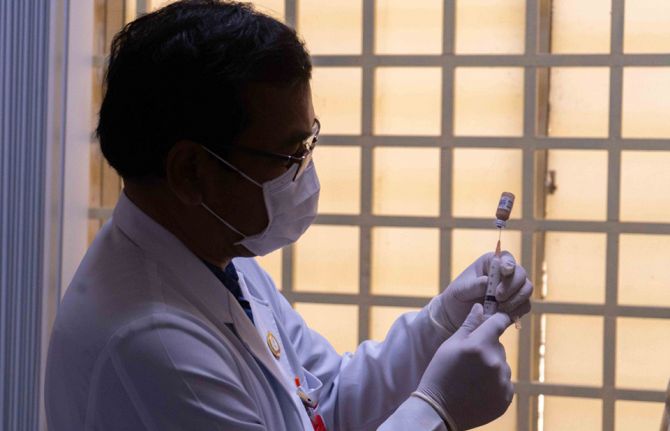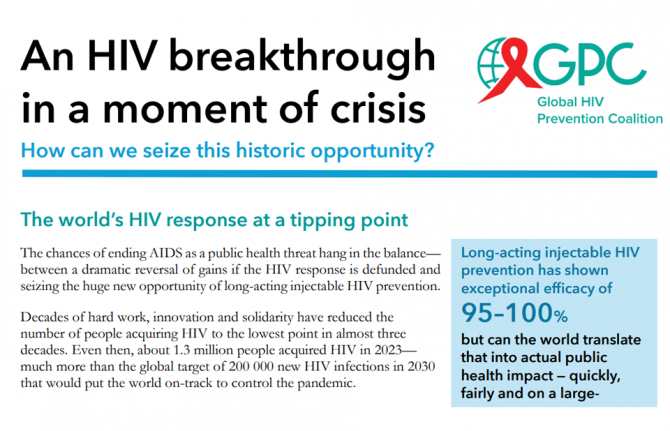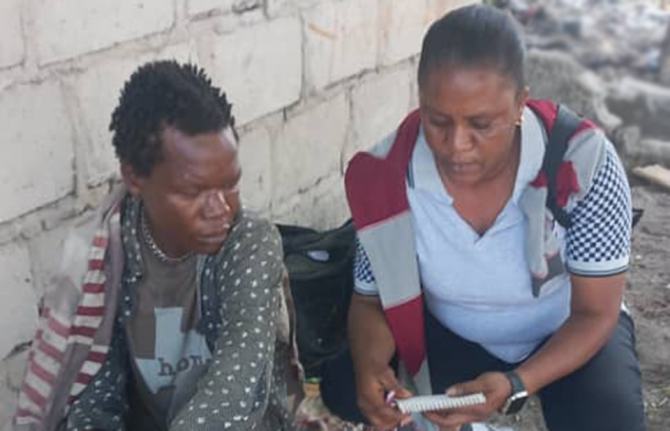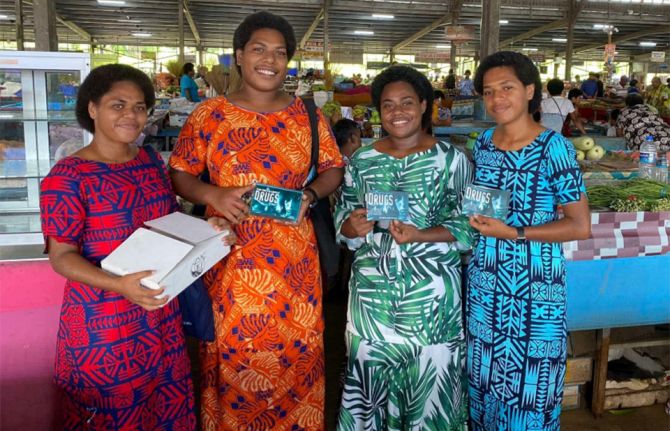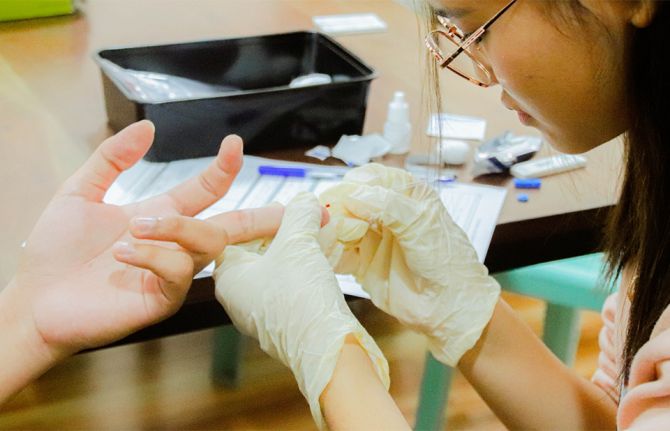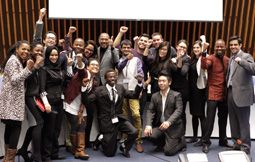
Feature Story
Scouts get the HIV message
16 August 2007
16 August 2007 16 August 2007As part of the international scout jamboree held in Britain over the summer, UNAIDS ran workshops on HIV prevention, personal responsibility in HIV transmission and respect for the human rights of positive people.

40,000 teenagers from all over the world attended
this year's world scout jamboree.
This summer, residents of Chelmsford, a town in eastern England, woke up to an unusual array of sights and sounds.
The banging of early morning drums and excited screeches of hundreds of teenage boys and girls filled the air – this was the international scout jamboree, and the 40,000 teenagers attending from all over the world wanted to make sure everyone knew it!
For UNAIDS staff attending the jamboree to run special workshops on HIV prevention, personal responsibility in HIV transmission and respect for the human rights of positive people, it was a bit of an eye opener. “We would look at each other and think: ‘Are you as lost as I am?’ ” laughs Bhatupe Mhango, coordinator of UN Plus – the UN system-wide group of staff living with HIV, who took part in the event with Alex McLelland, an intern with UNAIDS, in the Civil Society Partnerships Unit. “But we became hooked on those sessions every morning. I still hear them drumming and humming in my ears,” she says.
This was a particularly significant jamboree, as it marked the centenary of scouting and 40,000 teenagers attended from all over the world. UNAIDS had an area in the Global Development Village, a section dedicated to workshops on human rights and the work of UN agencies.
“The scouts as a movement has so much potential to mobilize towards the HIV response,” says Alex, who is studying for a degree in International Development at York University in Toronto, Canada . “They are eager to get further engaged. With approximately 28 million young people as members you can see the possibilities.”
Bhatupe and Alex planned and ran five workshops on the topic “HIV Sensitisation and Safeguarding Human Rights.” One of the UNAIDS objectives was to initiate a dialogue on the need for a policy to work with HIV positive scouts, and for UN Plus to look for possible partnerships.
“We established that there are some Positive scouts in several countries, particularly Africa, and UN Plus could foster a partnership with them,” says Bhatupe.
Over three days, he and Bhatupe spoke to youngsters from Norway , Germany, Italy, Chile, Brazil, Denmark, Britain, Turkey and Finland.
In spite of the big subject, it was all very informal. “Most of the workshops took place outside because the young scouts wanted to lie on the grass,” says Bhatupe. She and Alex shared their personal stories as people living with HIV. Scouts asked questions about stigma, treatment, nutrition guidelines and human rights issues for people living with HIV.

Bhatupe Mhango, coordinator of UN Plus, during a
live radio interview with the jamboree radio station,
promoting the workshops and encouraging scouts to
be aware of the means to protect themselves from
HIV transmission.
Bhatupe also did a live radio interview with the jamboree radio station, to promote the workshops and encourage scouts to be aware of the means of protecting themselves from HIV transmission.
There were the obvious drawbacks of talking about sex to teenage boys: “A memorable moment was watching young, Italian boys laughing hysterically at a UNFPA-led workshop we participated in, demonstrating male condoms using bananas,” says Bhatupe.
But many of the scouts showed real insight and understanding into the issue – Alex and Bhatupe were delighted by a group of 14-16 year old girls from Chile, who were well informed about HIV, AIDS and sex, having studied the subject at school. The girls held a debate on abstinence versus early sex.
“The maturity of the debate convinced me that the message on HIV prevention and empowerment of young girls is getting across,” says Bhatupe.
The girls were evenly divided - indicating that no one method is the obvious solution to managing yourself as a young woman in a relationship.
The views expressed included:
“If I love my boyfriend and I trust him…and if he has gone for an HIV test and tells me he is HIV negative, why should I not express my feelings for him and have sex with him? If that is what I want to do, I will just go ahead…if you love someone, you can not put controls on what you can do with that person.”
“For me I say no. I have to wait until I am married before I have sex. It is scary. I am scared of getting HIV or falling pregnant so the best thing to do is to wait.”
For Bhatupe and Alex, the UNAIDS messages were getting across: prevention, personal responsibility in HIV transmission, the need for more support and less stigma for positive people.
Alex was encouraged to see so much focus on AIDS at the jamboree.
“There were other workshops from UNFPA, UNICEF, UNESCO, as well as the South African and Ugandan Scout associations. The Girl Guides did a big presentation about HIV. The ILO discussed child labour and vulnerability to HIV.
“There’s a quite a lot of awareness among the Scouts. It was gratifying to see so much going on,” he said.
Links:
Visit the world scout jamboree web site
More information on young people and HIV
Related

Feature Story
New Blog gets HIV science online
10 August 2007
10 August 2007 10 August 2007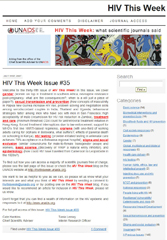
This newly launched UNAIDS' blog
offers up-to-date insight into
scientific developments within the
AIDS response.
For the latest news, views and reviews on HIV coverage in the scientific literature – log on to http://hivthisweek.unaids.org !
This newly launched UNAIDS' blog offers up-to-date insight into scientific developments within the AIDS response as covered in specialist and general medicine journals. The blog includes accompanying editorial notes and also gives visitors the opportunity to make comments about the blog’s issues and contents.
Created in 2006 as an internal e-newsletter for UNAIDS staff, HIV This Week is collated by the Chief Scientific Adviser to UNAIDS, Catherine Hankins, and her team.
“In the HIV field, and particularly for people on the ground in countries across the world, there can be an overload of information. What we aim to do is make people’s lives easier by searching the literature and selecting key articles that they can access to easily keep abreast of the latest scientific discussions and developments,” said Hankins.
“We’ve been putting together and circulating tables of contents from scientific journals internally since 2002 but decided to expand the service and make it more reader-friendly by selecting a few scientific abstracts each week,” she explained.
“No one really knew the extent of the thirst out there for scientific information on HIV. Initially we sent this out to UNAIDS staff only but the feedback we got was incredible. People started spontaneously forwarding the e-newsletter outside to external colleagues and partners, and responding to us with comments. We realised the potential interest and decided that the interactive nature of a blog would fit perfectly for HIV This Week,” Hankins said.
Now available online, the HIV This Week blog features select abstracts of key publications on HIV featured in leading scientific journals in the preceding weeks. From basic science to community resilience, TB/HIV to stigma, and male circumcision to gender issues – HIV This Week covers a wide range of thematic areas in every edition.

Created in 2006 as an internal
e-newsletter for UNAIDS staff, HIV This
Week is collated by the Chief Scientific
Adviser to UNAIDS, Catherine Hankins,
and her team.
“We feature about ten different themes in each edition, providing the abstracts of relevant articles, and, we hope, some enlightening editorial comments. These analyse and help contextualize the findings within the context of the response to AIDS and underscore, where relevant, what UNAIDS is doing in the various fields,” Hankins said.
Readers can click on keyword links to find all current and previous information on specific themes and issues covered in the blog. A search function also gives users an additional tool for browsing the site. Previous editions are available in the archive as pdf files, with the html files being uploaded now.
The blog also gives details of how to access journal articles depending on where you are. “We have included all the steps that people in different parts of the world need to follow to get access to articles, as our readers come from many different countries and contexts,” Hankins explained.
And your opinion counts. With the interactive feedback feature, the team hopes to receive comments and questions from fellow bloggers. “We are excited to get people’s reactions to the blog and its content – this way we can spark new dialogues. The picture we’ve used on the homepage of the blog shows people discussing and interacting—we want to get people talking about HIV!” Hankins said.
For anyone working in the HIV field, HIV This Week provides a mine of information that is easy to digest, simple to use and a critical tool to provide background on the latest scientific developments on AIDS. Log on to HIV This Week today!
Links:
Visit the 'HIV This Week' blog
Related
 An HIV vaccine: who needs it?
An HIV vaccine: who needs it?

21 July 2021
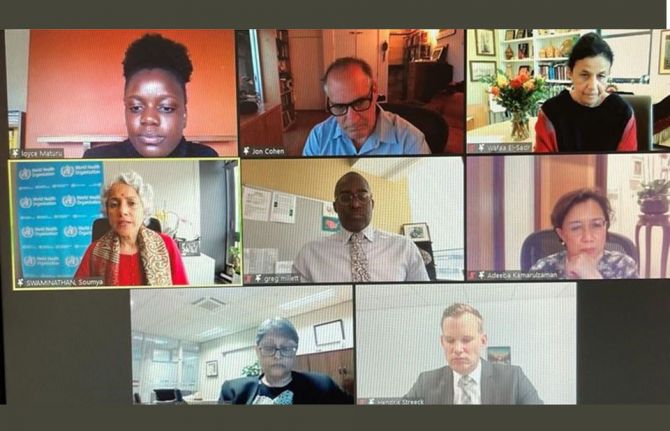 Science, HIV and COVID-19—where are we headed?
Science, HIV and COVID-19—where are we headed?

08 June 2021

Feature Story
Hope for street children
12 January 2007
12 January 2007 12 January 2007
Dawn has just broken in Cairo, Egypt, but Ahmed is already out on the street. But unlike other children Ahmed is not on his way to school. Ahmed is 12 years old and left home when he was just six because his father in law didn’t want him in the house. After wandering from one house to another, he found that it was easier for him to live on the streets. At that time he didn’t realise that it was far more dangerous too. When the social workers of Hope Village found him, he had been beaten up, robbed many times and raped twice. Hope Village provided him with a safe place to stay and offered him much needed shelter, care and support. “We also enrolled him in an HIV session where he learned how HIV is transmitted,” said Nawara a sociologist at the Hope Village. “After what’s happened to him he is very worried that he could be positive himself,” she added.

Hope Village Society was initially created to provide shelter and support to orphaned children from one of Cairo’s poorer neighbourhoods. However, a fter two years, they realized that the local street children also needed a safe place to go where they could receive care and support so they opened a day care center. The inauguration of this centre in the Shubra district of Cairo was soon followed by many others including one in the district of Sayeda Zeinab where Ahmed and other young boys come to seek refuge and comfort when the streets of Cairo become too much for them.
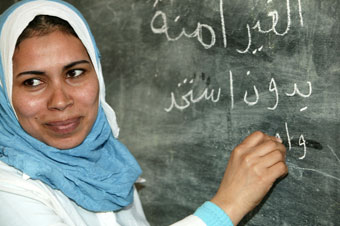
Twenty three year old Nawara has been working at Hope Village for about a year. She said that although her job is very tough it is also very rewarding, “these boys really need our help” she said. “The most difficult case I encountered, she recalled, was one of an 11 year old boy whose father threw him off the window because he was being too loud. I go with the kids when they have their medical examinations and I am shocked by what I see on their bodies–– bruises, cuts, infected wounds––It’s difficult to imagine what these kids go through,” she said.
Khalid Dawoud has been working with Hope Village for the past 17 years. He set up the Sayeda Zeinab day care centre. “I know the story inside out and I know what those kids are subjected to,” he said.
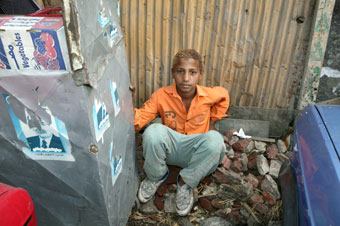
During his experience with Hope Village, Khalid noted how interested the children were in knowing more about HIV because of the dangers they face, from sexual assaults to drugs, violence and prostitution. Sex, both forced and voluntary often takes place at and other deserted places. The girls are usually more at risk because they are abused by the older street boys, by the police and others. Some girls accept to have sex for a sandwich, others do it to ensure protection in return. “It’s critical…” said Khalid “…that they know how to protect themselves from HIV. When we announced that we would open a testing centre soon, all of the kids wanted to be tested to make sure they are not infected with HIV.”
With help from UNICEF and other sponsors, the Hope Village Society undertakes a wide range of activities from providing boys and girls with care and shelter to offering them psychological support, training and behavorial skills to help them reintergrate into society.
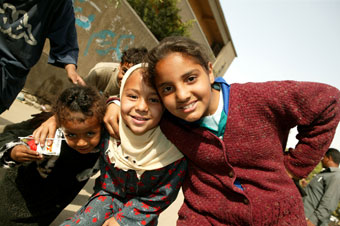
“Working with such initiatives is one of our priorities in Egypt,” said Maha Aon, UNAIDS Country Coordinator in Egypt. “We know how important and effective it is to focus interventions on people who are most likely to be exposed to HIV infection. One of the ways to protect street children is to help them understand where the risks are and how they can protect themselves in a way that they understand and which helps them care for and respect themselves.”
UNICEF, in collaboration with UNAIDS provides training on AIDS issues for the social workers at Hope Village . Nawara, who did the course in March said that the information she received and the methods of participatory teaching helped her a lot with the children. “We learned to use games to communicate information about HIV and about the dangers of life on the street, from an HIV perspective,” she said. AIDS awareness has become an integral part of the work carried out by Hope Village to help the children.
Dr Erma Manoncourt, Chair of the expanded Theme Group on HIV and UNICEF representative in Cairo said, “We need to mainstream HIV into existing programmes and develop programmes and interventions which focus on reducing the vulnerability of marginalized groups, including HIV prevention and impact mitigation,” she added. “We are reaching out to the private sector and other civil society entities and working with NGOs and community-based organisations, and at the same time, we collaborate with and support the Government. All these efforts are needed to make a difference for those who have no one else to care about them,” she concluded.
All photo credits: UNAIDS/P.Virot
Links:
Hope Village Society (Egypt)

Feature Story
Gender and AIDS in the Middle East and North Africa
08 August 2007
08 August 2007 08 August 2007
Fouzia Abdallah, National AIDS Programme
Manager Yemen and Somaya Al-Jowder, National
AIDS Programme Manager Bahrain during the
meeting.
Empowerment of women and promotion of gender equality were underlined as critical to reducing vulnerability to HIV in the Middle East and North Africa [MENA] at a recent gathering of experts from the region.
Specialists working in the areas of HIV and gender joined at a think tank meeting on “Gender and HIV in the Middle East and North Africa”, organized by the UNAIDS Regional Support Team MENA in Cairo, Egypt.
As the HIV epidemic in the MENA region continues to spread, the number of women living with HIV is increasing and the gap in prevalence rates among men and women is narrowing. Participants at the meeting agreed that gender inequalities across the region help fuel vulnerability and increase exposure to HIV infection. “Gender inequalities is and must be at the core of our national AIDS responses ,” said Fouzia Abdallah, the National AIDS Programme manager of Yemen.
Traditions and the role of religion were widely discussed by participants. The Minister of Family
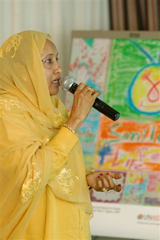
The Minister of Family Affairs and
Social Development in
Somaliland, Fadume Haji Adam
Affairs and Social Development in North West Somalia, Fadume Haji Adam, gave an opening address looking at specific cultural and religious traditions in the region that have an impact on women and girls in the context of HIV.
“In our traditions lie our challenges, and it is also there we will find the solutions,” she said.
Adapting strategies on gender and AIDS to fit the regional context was highlighted as fundamental to a successful response. Giving examples of how AIDS responses have failed to adequately address the situation of Muslim women, Dr Nafisa Mohamed Abdelkarim from Afhad University for Women in Sudan, called for a deeper understanding of the contexts in which many women and girls in the region find themselves“:
“ We cannot adopt an international agenda on gender and AIDS, we must develop our own agenda. We have to find our own solutions and strategies,” she said.
Often, our women do not make individual choices. They make their decisions within their social contexts. Our responses to AIDS have to address these contexts, and not only the individuals. We have to make AIDS our agenda, with a language and with interventions that speak to us and our situations ,” she added.
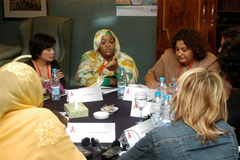
Adapting strategies on gender and AIDS to fit the
regional context was highlighted as fundamental to
a successful response to the AIDS epidemic.
The meeting brought together people from some of the most conflict-affected areas in the world. A key concern of participants was how to keep gender and AIDS high on an already full political and media agenda. “ The agenda is already full of immediate and emergency-related issues. At the same time, we can see how conflict situations increase vulnerability to HIV,” said Laila Baker, Assistant Representative for UNFPA, Occupied Palestinian Territory.
Rather than putting all our efforts in an emergency mode, we have to keep an eye on gender and AIDS in conflict situations. We can not afford ignoring such a crucial development issue ,” she added.
Building on this Think Tank meeting, the group identified key activities for moving forward, including reviewing national responses to AIDS in the context of gender, building capacity among national partners to further strengthen a gender-sensitive response, and mobilizing key ministries and partners to address gender and AIDS in the region.
Links:
More information on the Middle East and North Africa region

Feature Story
HIV prevention wins gold with African athletes
03 August 2007
03 August 2007 03 August 2007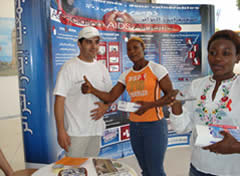 Young athletes from across the continent visited
Young athletes from across the continent visited the AIDS awareness stand to learn more about HIV
prevention tools and techniques.
Photo credit: UNAIDS
As the flags were hoisted, national anthems sung and medals presented, HIV prevention emerged as a new champion at the 2007 All Africa games held in Algeria in July.
While athletes from across the continent ran, jumped, threw and sprinted their way onto the medal winners podium, volunteers from Algerian NGO ‘AIDS-Algerie’ kicked off a ‘Games’ HIV prevention campaign for young people in all key competition and residential sites across the Algerian capital Algiers.
Young athletes were encouraged to visit special AIDS awareness stands, where they were able to find out AIDS-related information and learn more about HIV prevention tools and techniques. With special screening of HIV prevention videos and distribution of condoms, the AIDS campaign reached out to some 25,000 young African athletes.
“The awareness raising teams were able to encourage real interest and participation from the young African sportsmen and women,” said Professor Abdelkader Semid, President of the Medical Commission for the African Games organizing committee. “This opened people’s eyes to the risks of HIV infection and the need for HIV prevention,” he added.
Organized with the support of the Games’ steering committee, UNFPA, UNAIDS Secretariat and the Global Fund, the campaign demonstrated how HIV prevention can be successfully integrated into sporting events.
 The AIDS campaign reached out to some 25,000
The AIDS campaign reached out to some 25,000African athletes.
Photo credit: UNAIDS
“The global response to AIDS needs everyone to get involved – from all sectors of society. This huge event gave us excellent access to leaders among Algerian and African youth – we hope this will encourage them to carry on our association’s mission to respond to AIDS,” Mr Adel Zeddam, President of ‘AIDS-Algerie’.
Athletes attending the awareness-raising stands underlined their enthusiasm at taking part in the activity and their wish to move forward the AIDS response.
“This is a great activity for people like us doing sports all around the world. It’s a really special programme and I would like to see it replicated across the world so people can protect themselves better,” said Candy, an athlete from Nigeria.
Ivorian Judo champion Camara Mangue agreed: “I would like to call for all generations to face up to AIDS – it’s everybody’s issue.”
“The world must unite and fight AIDS,” said Namibian boxer Tobias.
Following the success of the campaign, it is hoped that the HIV prevention campaign will become a regular feature of future Games and other sporting events on the continent.
“Sport is a force for change and involving young people in sports and HIV prevention campaigns can empower them to be strong and become leaders on both fronts,” said UNAIDS Country Coordinator for Algeria Dr Samia Lounnas Belacel.
Links:
More on Sub-Saharan Africa
More on North Africa
More on sports and HIV

Feature Story
UNAIDS and Indian business giant to link up for AIDS
02 August 2007
02 August 2007 02 August 2007
UNAIDS and India’s largest private company, Reliance Industries Limited, are working to strengthen collaboration on AIDS issues with the aim of promoting greater access to HIV information, prevention and treatment services across India.
The idea for greater collaboration between the Indian industry giant and UNAIDS came during a recent meeting between Reliance Industries Limited’s (RIL) Chairman and Executive Director, Mukesh Ambani and UNAIDS Deputy Executive Director, Michel Sidibe where they discussed the AIDS situation in India. Full scope of greater collaboration and a potential partnership is currently under development.
This is not the first time RIL has acted on AIDS issues - the company received the UNAIDS Civil Society Awards 2006 in recognition of its outstanding commitment and support of the national AIDS response on the occasion of the World’s AIDS Day – December 1, 2006. RIL received a high profile corporate award for business response to AIDS 2007 in recognition of its existing AIDS interventions within Indian industry.
UNAIDS has played a leading role in helping put in place the RIL AIDS workplace policy and in shaping their efforts in responding to AIDS in India.

Feature Story
Caribbean faith leaders respond to AIDS
30 July 2007
30 July 2007 30 July 2007 AIDS claimed an estimated 27,000 lives in the
AIDS claimed an estimated 27,000 lives in theCaribbean in 2006.
Photo credits: UNAIDS
More than 130 religious leaders from the Caribbean joined in Barbados to discuss their role in moving the AIDS response forward and the importance of breaking down AIDS-related stigma and discrimination.
The inter-faith forum concluded that to be truly effective in challenging the AIDS epidemic, faith-based organizations must open their doors to people living with HIV and people at risk of HIV.
“We have to throw our doors wide open and make everyone welcome. We should lead from the front, whether this means opening up to everyone, or being the first to get tested for HIV, said Dr Nigel Taylor, President of the Barbados Evangelical Association (BEA).
Hosted by the Barbados BEA with the Barbados National HIV/AIDS Commission and UNAIDS, the two-day forum discussed inclusion and human sexuality in the context of AIDS.
Speaking at the event, Sir George Alleyne, the UN Secretary General’s Special Envoy for HIV/AIDS in the Caribbean underlined that faith-based organizations should adopt a radical and realistic stance: “I ask that you include not only those persons who are known to be HIV positive or those who declare themselves to be. I will be bold enough to ask that you include those who have been excluded because their lifestyles have not conformed to what has been considered the societal norm,” he said.
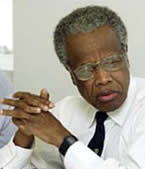
Sir George Alleyne, UN Secretary
General’s Special Envoy for
HIV/AIDS in the Caribbean
took part in the forum.
AIDS claimed an estimated 27,000 lives in the Caribbean in 2006 and is now the leading cause of death in adults aged 15-44. Underlining the severity of the epidemic in the region, Dr Carol Jacobs Chair of the National HIV/AIDS Commission of Barbados said a more open approach by faith-based organizations is not only a moral imperative, but is crucial for a successful response to HIV in the Caribbean.
“We all need to pull together and we can harness the power of faith-based organizations, with all their influence in our society, to really tackle stigma and discrimination, against, for example, men who have sex with men and sex workers,” she said.
“If such groups are included, it will mean that we can all talk more freely about the virus and what we can do to prevent it without fear of anyone being condemned and left out in the cold.”
Links:
More on the Caribbean
Related

Feature Story
Sydney AIDS Conference reports on scientific advances in HIV treatment and prevention
25 July 2007
25 July 2007 25 July 2007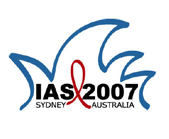
The 4th IAS Conference on HIV Pathogenesis, Treatment and Prevention came to a close in Sydney, Australia today. More than 5,000 delegates from 133 countries came together for the four-day conference to examine the latest developments in HIV-related research.
“The science presented here in Sydney is not only about new advances in treatment and prevention -- as important as those are -- but also about how to support developing countries in strengthening health delivery systems to make those advances a reality for people in need and at risk," said IAS President Dr. Pedro Cahn, International Conference Co-Chair and Director of Fundación Huesped in Argentina.
HIV clinicians and community leaders heard reports from some of the world’s leading researchers involved in basic, clinical and prevention science. Presentations included the roll out of antiretroviral treatment in the developing world and the need for research to inform treatment scale-up, HIV/TB co-infection, and ethical and practical issues related to HIV prevention research.
Emphasising the need to scale-up TB/HIV programmes Michel Sidibe, UNAIDS Deputy Executive Director of Programmes, UNAIDS said, "Urgent investment in TB research and programmes is needed if we are to avoid TB, and especially drug resistant TB, undoing all the advances we have gained through better AIDS treatment and care. All of our drugs, diagnostics and vaccines date from the last century or even the century before that."

Opening ceremony.
Photo credit: IAS
The scientists, clinicians, public health experts and community leaders also heard about research on novel prevention and treatment strategies, the cutting-edge use of gene therapy to treat HIV disease, female-initiated prevention technologies, provider-initiated HIV testing and the prevention of mother-to-child transmission.
“With fewer than one-third of people living with HIV in low- and middle-income countries having access to life-saving medications, and still fewer with access to proven prevention services, such as condoms and sterile syringes, the goal of universal access by 2010 must remain a priority,” said IAS President Dr. Pedro Cahn, International Conference Co-Chair and Director of Fundación Huesped in Argentina. “Science has given us the tools to prevent and treat HIV effectively. The fact that we have not yet translated this science into practice is a shameful failure.”
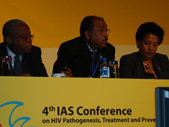
The conference was opened with a declaration from the organizers urging that 10% of all resources dedicated to HIV programming be used for research. By the close, more than 1,550 scientists, clinicians, policy makers and community leaders from around the world had signed the Sydney Declaration.
The International AIDS Society announced the selection of Cape Town, South Africa, as host of the 5th IAS Conference on HIV Pathogenesis, Treatment and Prevention in July 2009. The event will be organized by the IAS, in partnership with South African-based non-governmental organisation Dira Sengwe, the organizer of the South African AIDS Conferences.
Links:
Visit the web site of the International AIDS Society

Feature Story
4th IAS Conference on HIV Pathogenesis, Treatment and Prevention in Sydney
25 July 2007
25 July 2007 25 July 2007The Australian Society for HIV Medicine and the International AIDS Society were the hosts of the 4th IAS Conference on HIV Pathogenesis, Treatment and Prevention.More than 5,000 delegates from 133 countries came together for the four-day conference to examine the latest developments in HIV biology, pathogenesis, treatment and prevention science.Emphasising the need to scale-up TB/HIV programmes Michel Sidibe, UNAIDS Deputy Executive Director of Programmes, UNAIDS said, "Urgent investment in TB research and programmes is needed if we are to avoid TB, and especially drug resistant TB, undoing all the advances we have gained through better AIDS treatment and care. All of our drugs, diagnostics and vaccines date from the last century or even the century before that."
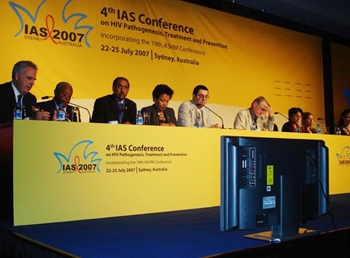 |
Presentations included the roll out of antiretroviral treatment in the developing world and the need for research to inform treatment scale-up, HIV/TB co-infection, and ethical and practical issues related to HIV prevention research. 22-25 July 2007, Sydney, Australia. |
 |
Deputy Executive Director of Programmes at UNAIDS, Michel Sibide, participated in events around treatment, sustainability in the era of universal access, the TB/HIV co-epidemic and men who have sex with men in Asia. 22-25 July 2007, Sydney, Australia. |
 |
UNAIDS supported an emotive exhibition at the Sydney AIDS conference portraying, in words and pictures the double impact that TB and HIV has on people and communities in South Africa and Zambia. |
Links:
Read Sydney AIDS Conference reports on scientific advances in HIV treatment and prevention
4th IAS Conference on HIV Pathogenesis, Treatment and Prevention opens in Sydney
4th IAS Conference on HIV Pathogenesis, Treatment and Prevention, Sydney 2007
Related
 An HIV vaccine: who needs it?
An HIV vaccine: who needs it?

21 July 2021
 Science, HIV and COVID-19—where are we headed?
Science, HIV and COVID-19—where are we headed?

08 June 2021

Feature Story
Global initiative to stop the spread of HIV among men who have sex with men
24 July 2007
24 July 2007 24 July 2007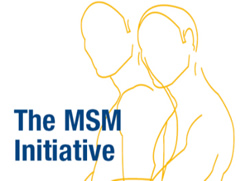
It’s an unfortunate reality that all too often, the people most at risk and most in need of HIV prevention, treatment and care programmes are those least likely to have access to these services. For example it is estimated that fewer than one in 20 men who have sex with men (MSM) around the world have access to HIV prevention, treatment, and care services.
In a bid to scale-up action and stop the spread of AIDS among men who have sex with men, the Foundation for AIDS Research, amFAR has launched an initiative to support grassroots MSM organizations at the International AIDS Conference in Sydney.
The initiative, in addition to directly supporting grassroots organizations, will also advocate for more research on MSM issues and fund global advocacy efforts aimed at mobilizing funding from international donors, national governments, and others. The advocacy program will also focus on launching campaigns to end the stigma, discrimination, and violence that threatens the lives of MSM and fuels the spread of AIDS.
“Empowering MSM and other marginalized groups to protect themselves from HIV is one of the world’s most urgent health priorities,” said Dr. Peter Piot, Executive Director of UNAIDS.
This initiative is important as evidence and experience show that focusing AIDS programmes and services specifically on people who are most at risk leads to encouraging progress within the response and can help reduce stigma and discrimination.
In Bangladesh for example, successful advocacy from the Banhu Social Welfare Society, including networking and participation in governmental meetings, ensured the inclusion of issues relating to men who have sex with men in the five-year National AIDS Strategic Plan.
In Indonesia, the Aksi Stop AIDS and Family Health International programme worked with the Indonesian authorities to highlight the contribution that communities of men who have sex with men can make. These communities now regularly participate in consultations on AIDS-related issues with the Ministry of Health.
In many countries, however, prevention efforts are hindered by laws that criminalize male-male sex, making work with men who have sex with men difficult and impeding their contribution to the response to the epidemic. Where social, cultural and religious attitudes make the issue politically sensitive, politicians can be reluctant to support policies and programmes that might result in public criticism from community leaders and groups.
Lack of research about men who have sex with men including their behaviours and attitudes, and criminalization and stigmatization of and legal discrimination against these men, are significant barriers to implementing effective programmes.
“A quarter century into the epidemic, MSM in many countries still do not have even the basic tools to protect themselves against HIV,” said Kevin Frost, acting CEO of amfAR. “We must have the courage to stand side by side with the grassroots organizations on the front lines of this epidemic delivering services and demanding greater action from governments. With funding and support, these organizations can transform attitudes, change policy, and mobilize funding to reverse the spread of HIV among MSM.”
Links
More on the MSM Initiative
Download the Best Practice: HIV and Man who have Sex with Men in Asia and the Pacific
Read more on men having sex with men
Download UNAIDS Policy brief on MSM ( en | fr | es | ru | pt ) (227 Kb, pdf)



